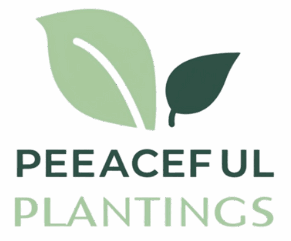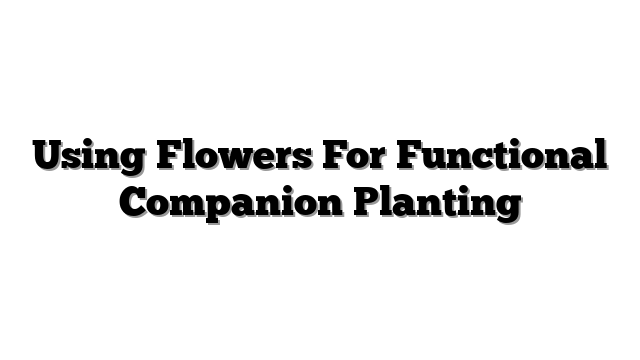Using Flowers For Functional Companion Planting
Pests eat your garden plants. Yields seem low. Maybe you want more bees. What can help? A simple flower might be the answer. Gardeners used old ways. This is companion planting. Flowers play a big role. They do more than look nice. They work for you. This guide helps you. Learn about Using Flowers for Functional Companion Planting. Make a garden that is healthy. Get more from your plants. Make it beautiful too. We will see how flowers work. Find flowers for pests. See flowers that bring good bugs. Learn how to plant them together. Let’s grow a better garden.
Beyond Beauty: What Functional Companion Planting with Flowers Really Means
Companion planting is an old idea. You plant different things together. They help each other grow. “Functional” means they have a job. They do more than just look pretty. Flowers have many jobs. They can scare bad bugs away. They can invite good bugs in. Good bugs eat bad bugs. They can bring bees and butterflies. Bees help plants make fruit. Some flowers make soil better. Others offer shade or support. Flowers are perfect for this work. They have bright colors. Their smells can be strong. Their roots do things underground. This old way is popular again. People want gardens without chemicals. Using Flowers for Functional Companion Planting fits this idea. It makes gardens healthier. It brings more different life. Pollination gets better. Plants grow strong. It is a beautiful way to garden.
Your Garden’s Best Friends: Attracting Beneficial Insects and Pollinators with Flowers
Good bugs help gardens. Ladybugs eat aphids. Lacewings eat many pests. Hoverflies prey on small bugs. Wasps can hunt caterpillars. Ground beetles help too. Bees and butterflies move pollen. This makes fruits and vegetables grow. Flowers bring these helpers. They offer sweet nectar. They give dusty pollen. They give places to hide. Some flowers have flat tops. This makes landing easy. Different colors call different bugs. Bloom time matters too. We want flowers all season.
Here are some good flowers. Plant Yarrow. It brings ladybugs. Lacewings like it. Small helpful wasps visit. It grows easily. Borage is great. Bees love its blue stars. It brings predatory bugs. It might scare away tomato worms. Its leaves and flowers are edible. Calendula is cheerful orange. It attracts hoverflies. Predatory wasps come. Lacewings find it. Aphids go there first. Dill and Fennel flower nicely. Their flower heads are flat. Tiny parasitic wasps like them. Hoverflies visit these too. Sunflowers are tall. They bring bees. They give birds seeds later. Zinnias and Cosmos are colorful. They have flat tops. They attract many bees. Butterflies visit them. Native wildflowers are best. They support local bugs. They help our area’s nature. A recent study showed this. Gardens with native flowers had more bees. They had different kinds of bees.
Plant these flowers near your veggies. Or make a special bug garden. A bug garden border helps. It gives bugs a home. They can work nearby. We give them food and shelter. They protect our plants.
Natural Garden Guardians: Using Flowers for Pest Control
Some plants keep bad bugs away. Their smell hides the smell of crops. Some roots release chemicals. These chemicals bother soil pests. Some plants confuse pests visually. Using Flowers for Functional Companion Planting includes this. It is a natural bug control method.
Marigolds are very famous. Plant French or African kinds. They repel tiny soil worms. These are nematodes. Marigolds can scare away whiteflies. They deter aphids. Thrips might stay away. Other pests avoid them. Scientists study how this works. The smell is very strong. Some think root stuff helps. Nasturtiums are another friend. Aphids love them. They go to nasturtiums first. This saves your other plants. Nasturtiums scare squash bugs. Cucumber beetles avoid them. Whiteflies don’t like them. You can eat the flowers and leaves. Chrysanthemums have a bug fighter. It is called pyrethrin. Planting them can deter some pests. Be careful with sprays from them. Geraniums scare cabbage worms. Japanese beetles avoid them. Petunias can help too. They repel aphids. Tomato hornworms dislike them. Asparagus beetles stay away.
These flowers help with pests. They are not a magic fix. Use them with other methods. It is one part of the plan. Plant these flowers close to plants pests like. Put them around the edge of your garden. Mix them in with your vegetables. This makes a natural wall. Find out which pests bother you most. Plant flowers that scare those pests. Plan where they will work best.
Growing Together: Best Flower & Vegetable Companion Planting Combinations
Now let’s put flowers with food plants. This is practical planting. It answers how to mix them. We see companion planting flowers and vegetables. Find the best teams.
Marigolds and Tomatoes work well. Plant them together. They scare away nematodes. Whiteflies leave tomatoes alone. Marigolds near Potatoes help too. Nasturtiums and Cucumbers are a good pair. They get aphids first. They scare squash bugs. Nasturtiums with Squash or Beans help. Borage helps Tomatoes. It brings bees for better fruit. Beneficial bugs come. They handle tomato worms. Borage helps Strawberries too. Calendula loves leafy greens. Plant it near Cabbage or Kale. It brings hoverflies. They eat aphids. They eat cabbage worms. Sunflowers can help Cucumbers. Plant them together. Cucumbers can climb the tall stalks. Sunflowers give some shade. They bring bees. Sunflowers near Beans help too. Zinnias and Cosmos make pretty borders. Plant them around your vegetable beds. They bring in bees and good bugs. They might keep pests near the edge. Sweet Alyssum is short. It spreads easily. It attracts tiny good bugs. Parasitic wasps like it. Hoverflies too. Plant it under taller plants. It keeps weeds down. It keeps soil moist.
Plan your garden layout. Where do you plant flowers? Mix them into rows. Plant blocks of flowers. Use them as a garden edge. Put them in pots near veggies. Think about sun needs. Think about water needs. Match flowers and veggies that like the same things. Sketch your garden first. Decide where flowers go. Put the right flower near the right veggie. Think about the pests you see. Think about needing more bees.
Expanding the Function: Flowers for Soil, Structure, and the Future of Gardening in 2025
Flowers do even more. Some help the soil. They have deep roots. These roots break up hard soil. This helps water sink in. Some flowers gather food from soil. Borage pulls up minerals. It brings them to the surface. When leaves die, they feed the soil. Some flowers cover the ground. Sweet Alyssum is low. It covers the soil. This stops weeds. It keeps soil cool. It holds water. This is like living mulch. Some flowers might show soil problems. They can be like soil indicators.
Functional flowers fit new garden ideas. Using native flowers is smart. They help local bugs. They need less water. They are strong plants. This is sustainable gardening. It uses less water and chemicals. It makes the garden stronger. Gardens in cities can use flowers. Small spaces work. Put flowers in pots. Grow them up walls. Nasturtiums hang down nicely. They grow with food plants. More flower types mean more life. This makes the garden healthy. It makes a strong system. Grow native flowers from your area. Find ones that help bugs or scare pests. Add them to your plan.
Putting it All Together: Planning and Planting Your Functional Flower Garden
Ready to start? Here is how you do it. First, look at your garden. What problems do you have? Too many pests? Not enough bees? Bad soil? Pick flowers for those jobs. Think about your sun. What kind of soil do you have? How much space is there? Choose flowers that fit your needs. Plan where they will go. Mix them in rows. Make borders. Put them in groups. Think about when they bloom. You want flowers all season. Get your soil ready. Good soil helps everything grow. Plant the flowers. Follow simple rules for planting. Water them. Cut off old flowers. This makes more flowers grow. Watch your garden. Do you see fewer pests? Do you see more bees? See what works. It takes time. Your garden gets healthier slowly.
Make a simple plan. Draw your garden beds. Write down your vegetables. Decide which flowers help them. Write down where to plant the flowers. Make a list for planting time. This helps you remember.
Frequently Asked Questions About Using Flowers for Functional Companion Planting
Can I use just any flower? No. Using Flowers for Functional Companion Planting means picking special ones. They are known to help with pests or good bugs. You need to do some research.
How many flowers do I need? It depends on your garden size. Think about where you put them. A few plants in the right spot work well. Put them near the plants that need help.
Will flowers hurt my vegetables? They might take water or food. Plant flowers that like the same things. Don’t plant too many in one spot. Healthy soil helps everyone.
Are some flowers bad for companion planting? Yes. Some grow too fast. Some might bring bad bugs. Some can stop other plants from growing. Always check before planting a new flower.
How fast will I see results? You see bees right away when flowers bloom. Pest help takes more time. It gets better over seasons. Your garden system gets stronger.
Cultivate Health and Beauty: Embracing Functional Flowers in Your Garden
We learned about this idea. Using Flowers for Functional Companion Planting does many things. It fights pests without chemicals. It brings in bees for more food. It makes your garden alive with bugs. It makes your garden beautiful too. This way of gardening works with nature. It is good for the earth. It is sustainable gardening. It is organic gardening. Start today. Try just a few flowers. See how they help. Your garden is a living place. Flowers make it healthier. They make it work better. They make it lovely. Plan your garden. Add some working flowers. Watch your garden grow strong.






